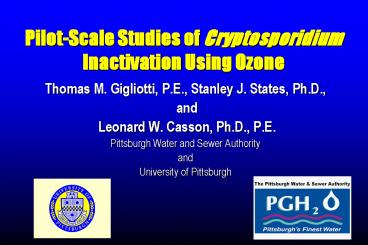PilotScale Studies of Cryptosporidium Inactivation Using Ozone - PowerPoint PPT Presentation
1 / 14
Title:
PilotScale Studies of Cryptosporidium Inactivation Using Ozone
Description:
Pilot-Scale Studies of Cryptosporidium Inactivation Using Ozone ... Oocyst viability was determined using the method of in-vitro excystation ... – PowerPoint PPT presentation
Number of Views:128
Avg rating:3.0/5.0
Title: PilotScale Studies of Cryptosporidium Inactivation Using Ozone
1
Pilot-Scale Studies of Cryptosporidium
Inactivation Using Ozone
- Thomas M. Gigliotti, P.E., Stanley J. States,
Ph.D., - and
- Leonard W. Casson, Ph.D., P.E.
- Pittsburgh Water and Sewer Authority
- and
- University of Pittsburgh
2
Problem Statement
- The Pittsburgh Water and Sewer Authority operates
a 60 MGD drinking water treatment and
distribution system - A series of seven open finished water reservoirs
were constructed in the 1800s and 1900s - By 1999, all open water reservoirs in the system
had been covered or replaced except for Highland
Park 1.
3
Problem Statement
- The Pennsylvania Department of Environmental
Protection has mandated that all finished water
reservoirs in Pennsylvania be covered - Highland Park Reservoir 1 has a volume of 125
MG and also serves as a scenic waterway within
the City of Pittsburgh and - Suggestions that this reservoir be covered for
public health considerations have been met with
strong resistance from citizens groups.
4
Overall Objective
- The objective of this pilot-study was to
investigate the use of ozone for inactivation of
Cryptosporidium in finished water, as an
alternative to covering a finished water
reservoir.
5
Materials and Methods
- Bench-Scale and pilot-scale ozone inactivation
studies were performed on live Cryptosporidium
parvum oocysts (approximately 3 x 106) in
finished water from Highland Park Reservoir 1. - Oocyst viability was determined using the method
of in-vitro excystation (Robertson et al., 1993). - Ozone residual in water was measured using an
Orbisphere (model 26506) monitor.
6
Materials and MethodsBench-Scale Studies
- Bench-scale inactivation experiments were
performed in 500 ml and 1L Erlenmeyer flasks - Ozone gas was bubbled through a diffuser stone
into solution. In addition, a teflon coated
magnetic stir bar and stirring plate were used to
disperse the ozone gas into solution and - Live Cryptosporidium parvum oocysts were pipetted
directly into the flask after a stable ozone
concentration was achieved.
7
Materials and MethodsPilot-Scale Studies
- Pilot-scale studies were performed using a
pilot-scale system consisting of two 10.75 foot
long 4 inch diameter glass contact chambers in
series - Fluoride tracer studies were performed to define
the hydraulic characteristics of the system - Ozone was injected into the system using a Mazzei
venturi injector (Model 384) and - Live oocysts were injected downstream of the
venturi.
8
Pilot-Scale Treatment Schematic
9
Bench-Scale Ozone Inactivation of
Cryptosporidium parvum oocysts
10
Pilot-Scale Ozone Inactivation of
Cryptosporidium parvum oocysts
11
Cryptosporidium parvum Inactivation Using Ozone
12
Summary and Conclusions
- In bench-scale studies using finished drinking
water, ozone inactivated up to 1.2 log-units of
Cryptosporidium - In pilot-scale studies using finished drinking
water, ozone inactivated up to 0.5 log-units of
Cryptosporidium at reduced water temperatures - Ozone inactivation of Cryptosporidium was
observed to decrease with decreasing water
temperatures
13
Summary and Conclusions(Continued)
- For similar CT values, ozone was observed to be
more effective in inactivating Cryptosporidium in
bench-scale studies than in pilot-scale studies - Bench-scale studies from this research and
previously reported research have shown ozone to
be an effective disinfectant for Cryptosporidium
however, pilot-scale results reported herein did
not support the findings of the bench-scale
studies
14
Summary and Conclusions(Continued)
- A scale-up factor must be applied in translating
results from bench-scale to pilot-scale. However,
this factor appears to be greater than reported
in the literature and - Additional pilot-scale studies are necessary to
confirm the results reported herein.






























